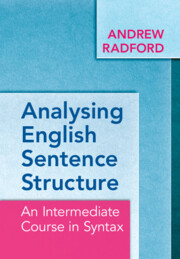Refine search
Actions for selected content:
6584 results in Grammar and Syntax

Analysing English Sentence Structure
- An Intermediate Course in Syntax
-
- Published online:
- 16 September 2023
- Print publication:
- 31 August 2023
-
- Textbook
- Export citation
Vasconian
-
- Book:
- Expressivity in European Languages
- Published online:
- 24 August 2023
- Print publication:
- 07 September 2023, pp 311-334
-
- Chapter
- Export citation
Frontmatter
-
- Book:
- Comparative Variation Analysis
- Published online:
- 24 August 2023
- Print publication:
- 07 September 2023, pp i-iv
-
- Chapter
- Export citation
1 - Introduction
-
-
- Book:
- Expressivity in European Languages
- Published online:
- 24 August 2023
- Print publication:
- 07 September 2023, pp 1-10
-
- Chapter
- Export citation
Index
-
- Book:
- Comparative Variation Analysis
- Published online:
- 24 August 2023
- Print publication:
- 07 September 2023, pp 217-218
-
- Chapter
- Export citation
Romance
-
- Book:
- Expressivity in European Languages
- Published online:
- 24 August 2023
- Print publication:
- 07 September 2023, pp 229-292
-
- Chapter
- Export citation
9 - A survey of expressive words in Breton
- from Celtic
-
-
- Book:
- Expressivity in European Languages
- Published online:
- 24 August 2023
- Print publication:
- 07 September 2023, pp 295-310
-
- Chapter
- Export citation
Index
-
- Book:
- Expressivity in European Languages
- Published online:
- 24 August 2023
- Print publication:
- 07 September 2023, pp 393-396
-
- Chapter
- Export citation
Contents
-
- Book:
- Comparative Variation Analysis
- Published online:
- 24 August 2023
- Print publication:
- 07 September 2023, pp vii-viii
-
- Chapter
- Export citation
12 - Parameters of variation in the syntax of expressive suffixes: Case studies of Russian, German, Spanish and Greek
- from Comparative
-
-
- Book:
- Expressivity in European Languages
- Published online:
- 24 August 2023
- Print publication:
- 07 September 2023, pp 361-392
-
- Chapter
- Export citation
10 - Vindicating the role of ideophones as a typological feature of Basque
- from Vasconian
-
-
- Book:
- Expressivity in European Languages
- Published online:
- 24 August 2023
- Print publication:
- 07 September 2023, pp 313-334
-
- Chapter
- Export citation
Uralic
-
- Book:
- Expressivity in European Languages
- Published online:
- 24 August 2023
- Print publication:
- 07 September 2023, pp 11-88
-
- Chapter
- Export citation
Tables
-
- Book:
- Expressivity in European Languages
- Published online:
- 24 August 2023
- Print publication:
- 07 September 2023, pp viii-ix
-
- Chapter
- Export citation
Celtic
-
- Book:
- Expressivity in European Languages
- Published online:
- 24 August 2023
- Print publication:
- 07 September 2023, pp 293-310
-
- Chapter
- Export citation
4 - Expressivity in Scots: A study of echo words
- from Germanic
-
-
- Book:
- Expressivity in European Languages
- Published online:
- 24 August 2023
- Print publication:
- 07 September 2023, pp 91-102
-
- Chapter
- Export citation
7 - Experimental Corroboration
-
- Book:
- Comparative Variation Analysis
- Published online:
- 24 August 2023
- Print publication:
- 07 September 2023, pp 141-165
-
- Chapter
- Export citation
4 - The Data
-
- Book:
- Comparative Variation Analysis
- Published online:
- 24 August 2023
- Print publication:
- 07 September 2023, pp 56-81
-
- Chapter
- Export citation
List of Tables
-
- Book:
- Comparative Variation Analysis
- Published online:
- 24 August 2023
- Print publication:
- 07 September 2023, pp xi-xii
-
- Chapter
- Export citation
References
-
- Book:
- Comparative Variation Analysis
- Published online:
- 24 August 2023
- Print publication:
- 07 September 2023, pp 191-216
-
- Chapter
- Export citation
Contributors
-
- Book:
- Expressivity in European Languages
- Published online:
- 24 August 2023
- Print publication:
- 07 September 2023, pp x-xiv
-
- Chapter
- Export citation
